You are using an out of date browser. It may not display this or other websites correctly.
You should upgrade or use an alternative browser.
You should upgrade or use an alternative browser.
Chengdu next gen combat aircraft (?J-36)
- Thread starter Blitzo
- Start date
Orca claims that CHAD might have the highest thrust to weight ratio of any fifth or sixth gen fighter aircraft.
Given the estimated ~50 to 60 tons of MTOW for the J-36 (which won't be reached for most combat operations), the WS-15 is to have 16 tons of max thrust per Cute Orca, meaning a combined max thrust of 48 tons.
Though, I do believe that the WS-15 (or its future derivatives) and also the WIP VCE-based WS-XX should be capable of reaching 17 tons - Or at the most, 18 tons of max thrust. This means a prospective combined max thrust of 51-54 tons for the J-36.
That means if the J-36 is a flying brick - Then the J-36 is going to be one hell of a flying brick.
This hasn't yet taking the absolutely gargantuan wing sizes into account, which point towards an absolutely superb wing area-to-wing loading ratio.
In the meantime, Cute Orca also dismissed the notion where future WS engines (low BP or VCE) meant for the J-36 will reach 20 tons or even 25 tons. Reasonable, given that fuel efficiency and power generation definitely takes precedence over pure max thrust for fighter jets, going forward.
Last edited:
Before the official data is released, it is always a smart choice to lower your expectations.Given the estimated ~50 to 60 tons of MTOW for the J-36 (which won't be reached for most combat operations), the WS-15 is to have 16 tons of max thrust per Cute Orca, meaning a combined max thrust of 48 tons.
Though, I do believe that the WS-15 (or its future derivatives) and also the WIP VCE-based WS-XX should be capable of reaching 17 tons - Or at the most, 18 tons of max thrust. This means a prospective combined max thrust of 51-54 tons for the J-36.
WS-15 max thrust is more than 16 tons. apart from design team, nobody knows the exact specifications of WS-15 but given the advancement of WS-10 latest variants it is reasonable to expect 16.5-17 tons for WS-15. which is absolutely fine. nothing exaggerating in this.
cute orca would have denied even CJ-2000 total thrust(78,000 lbf) if AECC didn't release the official specifications. LOL
----------------------------------------------------------------------------------------------------------------------------------
we barely know anything about WS-XX so wait for some details.. but both GE/PW have 20+ tons cycle engines in development.
Last edited:
asif iqbal
Banned Idiot
Given the estimated ~50 to 60 tons of MTOW for the J-36 (which won't be reached for most combat operations), the WS-15 is to have 16 tons of max thrust per Cute Orca, meaning a combined max thrust of 48 tons.
Though, I do believe that the WS-15 (or its future derivatives) and also the WIP VCE-based WS-XX should be capable of reaching 17 tons - Or at the most, 18 tons of max thrust. This means a prospective combined max thrust of 51-54 tons for the J-36.
That means if the J-36 is a flying brick - Then the J-36 is going to be one hell of a flying brick.
This hasn't yet taking the absolutely gargantuan wing sizes into account, which point towards an absolutely superb wing area-to-wing loading ratio.
In the meantime, Cute Orca also dismissed the notion where future WS engines (low BP or VCE) meant for the J-36 will reach 20 tons or even 25 tons. Reasonable, given that fuel efficiency and power generation definitely takes precedence over pure max thrust for fighter jets, going forward.
don't think for 6th generation thrust to weight ratio is as important as for the 4th or 5th generation fighters
plus 1:1 ratio is not that big a deal even top end Harrier has higher
If mtow is to be 50 to 60 tons, realistic empty weight would be 20 to 25 tons.
Given the size and 3 engines, internal fuel quantity may be 18-24 tons?
Max Air to air load may be around 3 tons.
If one third of fuel is used up before the zone of battle,
J36 might weigh some 40 tons, give or take a few tons, before entering an air battle.
Given the size and 3 engines, internal fuel quantity may be 18-24 tons?
Max Air to air load may be around 3 tons.
If one third of fuel is used up before the zone of battle,
J36 might weigh some 40 tons, give or take a few tons, before entering an air battle.
Orca claims that CHAD might have the highest thrust to weight ratio of any fifth or sixth gen fighter aircraft.
Wow. 3 engine does miracle. I guess the engines are something like 15000-16000 Kgf class for T/W=1 for MTOW assumption, it can support 48000 Kg/48 tonnes. Heavier than MiG-31 (46 tonnes). Of course if the airplane weigh less it will be incredible, say 38000 Kg like rated MTOW of Su-30MKI that would give 1.26 T/W.
Thanks, glad to once again be in a .mil role that isn't a package deal with infinite demotivation and getting yelled at for posting unclass retorts on the internet.
The problem isn't what you've said on the internet, but how you said it.
Top tier intelligence analysts tend to be fairly good at empathizing with the other side. It's how they're able to see things from opposing points of view, and recognize the parameters and forces shaping the other side's decision making and behavior.
However, the problem is that some, if not most of the people you work for would rather dismiss the other side as religious extremists, unreasonable ideologues, unpleasant rogues and/or comically evil.
They're not comfortable that you actually have respect for the other side, and it makes them question your loyalty, whether they'll verbalize it or not.
Recently, I have been researching supercruise and its impact on IR stealth. Some of you may have read this particularly pages 35-40, where Stillion argued that supercruising greatly compromise IR stealth and therefore supersonic speed should not be attempted. Specifically, table 4 claims thats supercruising at M1.6 increase the IR detection range by a factor of 2.9. If this is true and we assume the subsonic IR detection range to be 50km (PIRATE IRST claimed range), then a supercruising J-36 at M1.6 would be detected at 145km. This would imply that the supercruise capability of the J-36 are only relevant to rapidly moving from point A to B and are not well suited to air combat due to the IR stealth penalty. It would also imply that subsonic drones or even the B-21 are the ideal platform for future air combat, which is Stillion’s main point in the report.
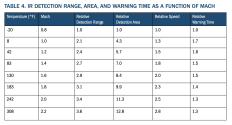
Actually, Stillion made several mistakes that significantly overestimated the IR stealth penalty. First, he incorrectly claims that the Mach cone is visible in IR and increase the effective area of a supersonic object. In fact, Mach cones are invisible and the front projection area of supercruising aircrafts are the same as subsonic aircrafts. As a result, his calculations overestimate the IR emission of supercruising aircrafts by a factor of around 10.
Second, he assumes the shock cone temperature applies uniformly to the visible forward projected surface area. This is not true as the temperature decreases moving away from the tip of the nose. So the average aircraft is cooler than his calculated numbers, although the specific degree depends on the design.
Third, he failed to account for IR reflections from the sun and earth. An IRST detects the combined the IR radiation from the thermal radiation from the object itself as well as reflected light. How signifiant are the reflection from the earth? According to this paper (), quite a lot. In fact the earth irradiance overshadows the IR emission at between 20 to 40 C. This roughly corresponds to supercruising at M1.5.

Additionally, there are a number of strategies aircraft designers can use to suppress IR signatures. These include reducing surface emissivity, concentrating emissions in atmospheric absorption bands and directional emission to reflect IR radiations away from threat sensors (the last strategy is particularly viable for stealth aircrafts because the same geometry good for radar stealth is also good for IR stealth).
Interestingly enough, most of the paper I came across while researching this topic from Chinese authors, and they have unique tastes in making their graphical illustrations on how their research may be applied. Some examples below:
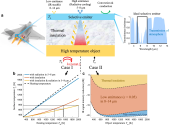
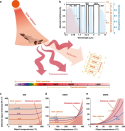
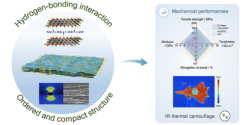
In conclusion, we should dispell the myth that supercruise is not compatible with IR stealth. The signature increase was overstated and there are many strategies to manage signature, with very active research coming out of China.
References:

Actually, Stillion made several mistakes that significantly overestimated the IR stealth penalty. First, he incorrectly claims that the Mach cone is visible in IR and increase the effective area of a supersonic object. In fact, Mach cones are invisible and the front projection area of supercruising aircrafts are the same as subsonic aircrafts. As a result, his calculations overestimate the IR emission of supercruising aircrafts by a factor of around 10.
Second, he assumes the shock cone temperature applies uniformly to the visible forward projected surface area. This is not true as the temperature decreases moving away from the tip of the nose. So the average aircraft is cooler than his calculated numbers, although the specific degree depends on the design.
Third, he failed to account for IR reflections from the sun and earth. An IRST detects the combined the IR radiation from the thermal radiation from the object itself as well as reflected light. How signifiant are the reflection from the earth? According to this paper (), quite a lot. In fact the earth irradiance overshadows the IR emission at between 20 to 40 C. This roughly corresponds to supercruising at M1.5.

Additionally, there are a number of strategies aircraft designers can use to suppress IR signatures. These include reducing surface emissivity, concentrating emissions in atmospheric absorption bands and directional emission to reflect IR radiations away from threat sensors (the last strategy is particularly viable for stealth aircrafts because the same geometry good for radar stealth is also good for IR stealth).
Interestingly enough, most of the paper I came across while researching this topic from Chinese authors, and they have unique tastes in making their graphical illustrations on how their research may be applied. Some examples below:



In conclusion, we should dispell the myth that supercruise is not compatible with IR stealth. The signature increase was overstated and there are many strategies to manage signature, with very active research coming out of China.
References:
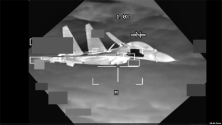
Here is an example of how material can affect IR signature. It is a MWIR photo of a J-11BS intercepting a B-52 over the SCS captured from presumably a SNIPER targeting pod. Note how the exposed titanium is black (low signature) while the rest of the painted airframe is white (high signature), even through they are the same temperature.
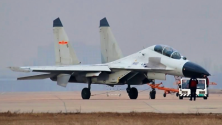
This is because the polished titanium has low emissivity (less emission at a given temperature in general) and is a directional emittor (emission tends to go perpendicular to the surface, so less emission towards the sensor).
